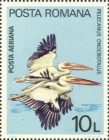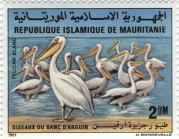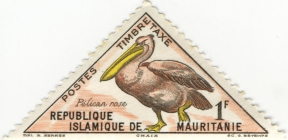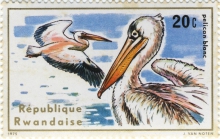WoRMS taxon details
Pelecanus onocrotalus Linnaeus, 1758
137176 (urn:lsid:marinespecies.org:taxname:137176)
accepted
Species
marine, terrestrial
Linnaeus, C. (1758). Systema Naturae per regna tria naturae, secundum classes, ordines, genera, species, cum characteribus, differentiis, synonymis, locis. <em>Editio decima, reformata [10th revised edition], vol. 1: 824 pp. Laurentius Salvius: Holmiae.</em> , available online at https://biodiversitylibrary.org/page/726886 [details] Available for editors  [request]
[request]
Description Size: 140-178 cm. Plumage: white; breeding birds have pinkish tinge; back of head with small crest; primaries, secondaries...
Distribution Old World
Description Size: 140-178 cm. Plumage: white; breeding birds have pinkish tinge; back of head with small crest; primaries, secondaries and primary coverts black (noticeable only in flight). Immature mostly grey-brown with some white on back and belly. Bare parts: iris red to red-brown; male facial skin pink to purplish, female facial skin orange; bill yellowish grey with pink edges and yellow pouch; feet and legs pink to yellow. Habitat: coastal bays and estuaries, and inland waters.<388><393><391> [details]
Distribution Old World
Distribution Old World [details]
WoRMS (2024). Pelecanus onocrotalus Linnaeus, 1758. Accessed at: https://marinespecies.org/aphia.php?p=taxdetails&id=137176 on 2024-04-24
Date
action
by
![]() The webpage text is licensed under a Creative Commons Attribution 4.0 License
The webpage text is licensed under a Creative Commons Attribution 4.0 License
original description
Linnaeus, C. (1758). Systema Naturae per regna tria naturae, secundum classes, ordines, genera, species, cum characteribus, differentiis, synonymis, locis. <em>Editio decima, reformata [10th revised edition], vol. 1: 824 pp. Laurentius Salvius: Holmiae.</em> , available online at https://biodiversitylibrary.org/page/726886 [details] Available for editors  [request]
[request]
basis of record van der Land, J. (2001). Tetrapoda, <B><I>in</I></B>: Costello, M.J. <i>et al.</i> (Ed.) (2001). <i>European register of marine species: a check-list of the marine species in Europe and a bibliography of guides to their identification. Collection Patrimoines Naturels,</i> 50: pp. 375-376 (look up in IMIS) [details]
additional source Brown, L.H., E.K. Urban & K. Newman. (1982). The Birds of Africa, Volume I. <em>Academic Press, London.</em> [details]
basis of record van der Land, J. (2001). Tetrapoda, <B><I>in</I></B>: Costello, M.J. <i>et al.</i> (Ed.) (2001). <i>European register of marine species: a check-list of the marine species in Europe and a bibliography of guides to their identification. Collection Patrimoines Naturels,</i> 50: pp. 375-376 (look up in IMIS) [details]
additional source Brown, L.H., E.K. Urban & K. Newman. (1982). The Birds of Africa, Volume I. <em>Academic Press, London.</em> [details]
 Present
Present  Present in aphia/obis/gbif/idigbio
Present in aphia/obis/gbif/idigbio  Inaccurate
Inaccurate  Introduced: alien
Introduced: alien  Containing type locality
Containing type locality
From other sources
Description Size: 140-178 cm. Plumage: white; breeding birds have pinkish tinge; back of head with small crest; primaries, secondaries and primary coverts black (noticeable only in flight). Immature mostly grey-brown with some white on back and belly. Bare parts: iris red to red-brown; male facial skin pink to purplish, female facial skin orange; bill yellowish grey with pink edges and yellow pouch; feet and legs pink to yellow. Habitat: coastal bays and estuaries, and inland waters.<388><393><391> [details]Distribution Old World [details]
| Language | Name | |
|---|---|---|
| Albanian | pelikani rozë | [details] |
| Bulgarian | Розов пеликан | [details] |
| Dutch | roze pelikaan | [details] |
| English | white pelicangreat white pelican | [details] |
| French | pélican blanc | [details] |
| German | Rosapelikan | [details] |
| Hebrew | שקנאי מצוי | [details] |
| Italian | pellicano | [details] |
| Lithuanian | rožinis pelikanas | [details] |
| Modern Greek (1453-) | Ροδοπελεκάνος | [details] |
| Norwegian | pvitpelikan | [details] |
| Norwegian Bokmål | hvitpelikan | [details] |
| Norwegian Nynorsk | kvitpelikan | [details] |
| Polish | pelikan różowy | [details] |
| Romanian | pelicanul comun | [details] |
| Russian | розовый пеликанПеликан розовый | [details] |
| Slovenian | rožnati pelikan | [details] |
| Spanish | pelícano común | [details] |
| Swedish | vit pelikan | [details] |
| Turkish | ak pelikan | [details] |
| Ukrainian | Рожевий пеліканПелікан рожевий | [details] |





